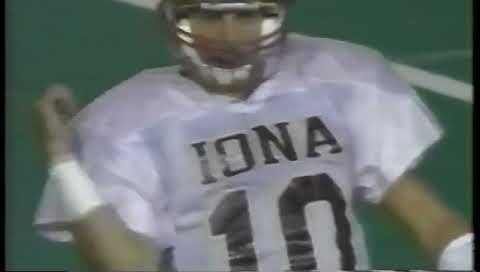Before its basketball program’s improbable run to this season’s Elite Eight, Saint Peter’s athletics barely registered a blip on the proverbial radar. Case in point: The closure of Peacocks football less than three months before kickoff of the 2007 season garnered only a brief in the Philadelphia Inquirer, in the same update announcing the launch of baseball at Chestnut Hill College.
Saint Peter’s ceasing football operations dealt another blow to the Metro Atlantic Athletic Conference, which limped through its final season with just four members: Duquesne, Iona, La Salle and Marist.
Only Duquesne and Marist still sponsor football.
Here’s a quick overview of the history of MAAC football members, most of which dropped like flies in the first half of the 2000s:
Canisius
Canisius sponsored football as far back as 1918, though was among the dozens of programs that shuttered commensurate with the Korean War1. But upon restarting in the late ‘60s, the Golden Griffins maintained the program for almost four decades before closing in 2002.
Coach Ed Argast told the Associated Press in November 2002, upon learning of the decision, “It’s us. That’s it. We’ve had each other all year, and that’s all we’ve got to hang on this week.”
Two days later, Canisius lost to Dayton, 42-6.
Duquesne
One of the survivors, Duquesne boasts a rather successful program still today as part of the Northeast Conference. The Dukes won eight MAAC championships under Greg Gattuso, a former UConn and Maryland assistant who since led UAlbany to its best season in program history in 2019.
Fairfield
Stags football existed for all of seven seasons, 1996 through 2002, but was surprisingly good in its abbreviated life. Kevin Kiesel headed up the program at its inception, and after a trying first season went 7-3, 9-2, 9-2 and 8-2.
In just the program’s third year, it won the conference championship.
Perhaps foreshadowing the program’s impending demise, Kiesel left Fairfield after an 8-2 finish in 2000 to coach at Div. II Millersville. In his introductory at Millersville, Kiesel cited both “financial and professional” motivations for his move, as reported by the Lancaster, Pennsylvania Sunday News.
Georgetown
Georgetown football is perhaps best known in modern times for Jim Gaffigan having been a member of the squad.
Bob Benson coached the Hoyas to a pair of MAAC championships before the program left for the Patriot League in 1999, where it remains today.
Iona
Iona football originally launched in the 1960s as a club program, which should not be confused for non-competitive. The club circuit of the late ‘60s featured some really quality teams, including a briefly relaunched Loyola Marymount team that won the national championship2.
The Gaels eventually transitioned to Div. III, then joined the MAAC once the NCAA mandated Div. I athletic programs could no longer sponsor Div. III affiliates — a move that killed off football at places like UC Santa Barbara. Iona saw MAAC membership through to the end, and played one season as an independent, but never latched onto the non-scholarship Pioneer or Patriot Leagues like Marist and Georgetown, or partial-scholarship NEC like Duquesne.
La Salle
While the 1940s were something of a golden age for college football, La Salle was among the universities to discontinue its program then. The Explorers went without football until 1997, a season that concluded with a lengthy feature story leading the sports section of the Philadelphia Inquirer.
The subhead promising La Salle was “in it for the long haul” wasn’t exactly the case. The Explorers shut down operations a second time in 2007. In 2009, the university athletic department settled a lawsuit with the family of former Explorer Preston Plevretes, who died from head trauma in 2005.
Plevretes’ death and the ensuing legal battle is a pivotal moment in the ongoing conversation about concussions in college football.
Marist
When MAAC football shut down in 2007, Marist soldiered on for a year as an independent before landing in the Pioneer League. The Red Foxes remain members of the non-scholarship conference, playing for Jim Parady — the same head coach who guided the program for the duration of its MAAC tenure.
Saint Peter’s
Saint Peter’s football history is unremarkable to such an extent that its lack of success was cited as a reason for its closure after the 2006 season. The 2001 campaign was an exception, however, as the Peacocks finished 10-1.
Along the way to a program-best season, Saint Peter’s scored a 19-0 defeat of FAU coached by Howard Schnellenberger. Yes, it was the Owls’ first-ever season, but given the context — a program destined for FBS, led by one of the greatest coaches in the sport’s history — the Peacocks’ win might qualify as the university’s biggest upset prior to the NCAA Tournament defeat of Kentucky.
Siena
Oddly enough, the football page still exists on Siena’s official athletic website despite the school dropping the sport 19 years ago.
There’s not a whole lot write, as Siena was pretty bad throughout its MAAC tenure. The Saints’ last head coach went 5-35 in four seasons, for example. Of interest to some, however, may be that Siena football alumni counts All Elite Wrestling talent Bobby Fish among its ranks.
St. John’s
Around the same time Lou Carnesecca was building St. John’s basketball into a national powerhouse, Bob Ricca led some good St. John’s football teams. The not-yet-rebilled-Red Storm won four straight championships in the Metro Intercollegiate Conference from 1981 through 1984.
The 1984 season marked the 100th anniversary of St. John’s playing football, too, making it far-and-away the oldest of the former MAAC members.
I tracked down a brief from The Sun in New York, recounting St. John’s road loss to Seton Hall in 1885. It’s sandwiched between updates on a head-to-head foot race and professional wrestling bout.
The 15-season life of MAAC football underscores the still-lingering financial challenges that face the majority of athletic conferences. Those challenges specific to the MAAC provided one of the prominent subplots of Saint Peter’s Elite Eight run, with reports of the Peacocks generating $8.1 million, but the revenue reportedly set to be distributed throughout the league’s members over a six-year period.
Realities for athletic departments like that of Saint Peter’s stand in such stark contrast to the hundreds of millions of dollars the SEC and Big Ten generate through their TV contracts. Some in college football media would have you believe the ACC, Big 12 and Pac-12 are living like paupers, but they each rake in exponentially more than the Group of Five conferences.
And all the FBS leagues take in more revenue than the rest of Div. I, the latter of which makes up the majority of the conferences.
John Bonamego, former head coach at Central Michigan — from that other conference pronounced like “mack” — told me in an interview a few years ago that he participated in other programs on the campus, like sponsoring a scholarship for band members, because he viewed football as emblematic of the university mission.
It’s a good point. For thousands, if not millions, the first introduction to a university comes through its athletic programs — specifically, the traditional revenue sports of men’s basketball and football.
Because MAAC members by-and-large don’t sponsor football3, that leaves basketball teams like Saint Peter’s to carry the banner. Daryl Banks III recognized as much during the Peacocks’ dream March.

While the distribution and ultimate impact of Saint Peter’s NCAA Tournament residuals may not be readily known just yet, it’s fascinating to wonder if an alternate timeline in which this run occurs before the football closed saves the gridiron Peacocks.
Likewise, what if Siena’s 2009 Tournament exploits had been just a few years earlier? Does it save Saints football?
Maybe not; likely not, even. If the economic downturn of the early 2000s was too much for those programs to navigate, the Great Recession that ended the decade almost certainly would have done those programs in later.
Still, consider how many Div. I universities launched football programs in the years since the MAAC ceased gridiron operations:
2008: Campbell
2009: Incarnate Word, Lamar, Old Dominion, South Alabama
2010: Georgia State, UTSA
2013: Charlotte, Houston Baptist, Mercer
2015: East Tennessee State, Kennesaw State
2019: Long Island4
And, in 2025, UT-Rio Grande Valley will play its first season in a testament to how far the school’s athletic department has come from its days with a conference-less basketball program that traveled the nation getting paychecks for blowout losses as Pan American.
Rationale for starting (and restarting, in a few instances) these programs is often the same: build up the student body’s sense of community, provide alumni another reason to return to campus (and another reason to donate), and attract more applicants. It’s no different today than at the turn of the 20th Century when the University of Chicago hired Amos Alonzo Stagg to coach football before the school even had a president.
The mack league in which Bonamego coached, the Mid-American Conference, has taken up residence on midweek television broadcasts5 to provide its football programs more of that visibility. Oddly enough, however, the MAAC beat the MAC to that idea.
Here’s Iona vs. Duquesne on ESPN2, Halloween night 1994 (a Monday!), with Dr. Jerry Punch (!!) and Mike Mayock (!!!) on the call:
1994 could well have been the jumping-off point for MAACtion well before MACtion. That same year also had the potential of seeing a Bo Jackson-like two-sport star emerge, but alas…
Had the pipe dream of Allen Iverson — a high-level prospect at quarterback as well as point guard — suiting up for Georgetown football become reality, The Answer would have plied his trade in the MAAC.
Among the noteworthy programs that closed down in the early 1950s are Creighton, Gonzaga and San Francisco, all of which boast 2022 NCAA Tournament basketball programs.
More on that at a later date.
As noted, Marist still sponsors football but plays in the non-scholarship Pioneer League. Monmouth participates in the MAAC for everything but football, and was never in the MAAC football league. Monmouth played in the Northeast Conference before going full-scholarship and moving to the Big South. Starting next season, Monmouth joins the Colonial Athletic Association in all sports.
Long Island University’s football program was born of a merge between the school’s campuses of LIU Brooklyn and LIU Post. It’s one of the more fascinating newcomers, however, as a rare Div. I program launching in the Northeast. What’s more, LIU is right in the footprint of the MAAC.
I’m adding a notation here to give the linked article a second plug: This Athlon Sports feature from 2018 on the significance of midweek MACtion and FunBelt is among the articles I’m more proud of having produced.








This is pretty cool! I knew Duquesne had a decent football program for their size, but I had no clue Saint Peter's ever had a team.